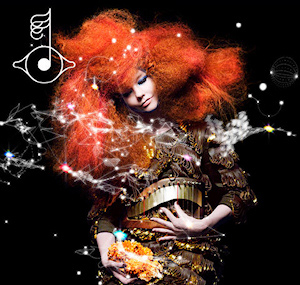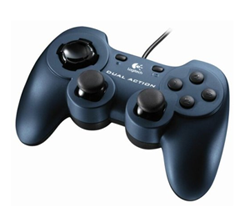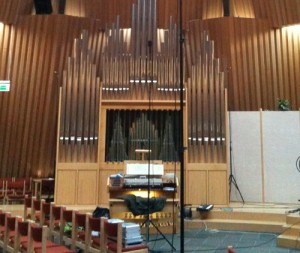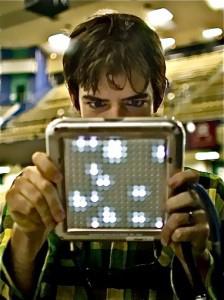Behind The Release: Björk Biophilia
This week, we count down to our AES presentation “The Studio As An Instrument” with panelist Damian Taylor (The Prodigy, Arcade Fire, Austra) who tells us about using custom interfaces and robotic instruments to create Björk’s Biophilia.
When Damian Taylor tells me about the making of Björk’s Biophilia, it’s with the inflection of someone who’s been raised all over the world. He has the mild, blended accent of a man who spent a decade each in Canada, the UK, New Zealand before ultimately settling in Montreal.
It’s also the kind of voice that sounds younger than its years. Even now with a wife, small children, and studio of his own, Taylor is always on the ready to laugh at absurdity, and himself. His default tone seems to be one of mild enthusiasm.
Similarly, Taylor’s roles with Björk have been varied as his upbringing, and he seems up for anything. He’s credited in all sorts of capacities, from musical director on her tours, to engineer on her albums to, even as a co-writer of a select few songs on her latest release. The best he can muster is to say that his role is “constantly evolving”:
“On Vespertine, I was in traditional programmer’s role, where on Volta I was with her through the whole thing. My responsibilities would vary from programming and studio engineering to driving a van and carrying a roadcase around,” he laughs.
Although Taylor did the lion’s share of engineering work on her latest albums, there was also room for downtime as Björk took more than two years to conceive and create the album. “If we went to work with Timbaland, Jimmy Douglass would be there with him of course. He’s just an absolute Don, so I might just get to just kick back and hang out with Jimmy Douglass for ten days. But the next month we might be on tour, and so much of it is constantly working or preparing. I think the best way to describe it is that I’m her technical enabler.”
IMAGINING BIOPHILIA
“Björk is a huge lover of technology,” Taylor says, “but she’s not a very technological person herself.”
It’s that kind of attitude, he thinks, that leads Björk to have the kinds of insights she does into how we relate to and interact with new technology.
Her latest album, Biophilia went through several conceptual stages before Björk ultimately decided to release it as an album and an Apple iOS application. As the first major musical release to really take advantage of the new medium, the Biophilia App has been getting a lot of press.
But Taylor reminds us that all the songs on the album except one were written before the iPad was even announced. At first, Björk conceived of the album as a literal house that listeners could visit, where all rooms would be filled with devices that would each play part of a song. At one point, the album was re-imagined as an IMAX film, complete with a working script that had a whole narrative plotted out.
Finally, the decision was made to release the music as both an album and as an interactive App that allows listeners to control the music and the corresponding visuals.
“Björk really came to love the iPad,” says Taylor. “She thinks the way you can interact with it is just an entirely different experience of computing. It wound up being the best vehicle for trying to present those ideas.”
In some ways the presentation of the album mirrors the way it was created. In the making of Biophilia Björk and Taylor became very interested in “electronic music and how you could control it in an instinctive way; without being bound by the normal rules of sequencers and samplers.”
THE “Apps” BEHIND THE MUSIC
Taylor says that the Biophilia App itself is like a “stripped-down, consumer version” of the very tools Björk used to capture and manipulate the sounds. He would know. He designed most of them.
“We thought it would be a cool idea to have an acoustic album, but to have the music all be generated electronically. In other words, we were using robotic instruments, but the performances were still being guided by a human.”
Instead of relying on conventional instruments to write the songs for the album, Taylor worked within Björk’s specifications to create a suite of unique virtual instruments in Max/MSP that she could then manipulate with a variety of unusual devices while singing.
In place of a traditional instrument or sampler, she would be able to trigger and manipulate her sounds with a Logitech videogame controller, the Telsa-esque tabletop Reactable system, or a first-generation multi-touch screen called the JazzMutant Lemur.
“I think the simplest way to describe what this system allowed her to do, is that there’s no way you could have written these songs on a piano. Compositionally, it allows you to form your ideas and control them very precisely – but in a way that’s completely different from what I’ve experienced playing any other instrument.”
The resulting music is captivating, even when the song forms are unconventional.
“It’s kind of polarizing, which is always funny to see. You’ll hear one amazing review ‘Oh my god – it’s just so stunning’ and then you’ll hear another person going, ‘What!? It’s just an unformed bunch of improvisatory crap!’,” Taylor laughs earnestly, heartily. “What people are pissed about, and what people love about Biophilia is that the structures are very unusual. They feel like they’re unfolding in the moment. To some, that’s ‘improvised bollocks’ and to others, it’s this unique and refreshing flow.”
Oddly enough for music that was captured using pioneering new software systems, the album itself is mostly comprised of first takes. Even though they were using digital technology, Taylor thought of the process as being a lot like tracking to tape; at least as far as performances were concerned. Although Björk’s voice and performances on the controller would remain largely etched in stone, the sounds of the instruments could be easily replaced.
This is where the idea of robotic instruments comes in.
On the song “Hollow” for instance, Björk’s voice was recorded, and her performance on the controllers were captured as MIDI data. But for the final version of the song, they brought their rig back to Iceland where Björk knew an organ-builder with novel device. He had a special robotic bar that could sit above the keys of a church organ, and was rigged to accept a regular MIDI input.
As the performance data was transmitted, tiny levers would descend from this robotic arm to push the organ’s keys while Björk made adjustments to the organ stops.
The record is filled with sounds that might be unexpected to some mainstream listeners. According to Taylor, Björk tends to have an idea of what kind of sound palette she wants to use going into each project. On this one she talked a lot about copper, which is where the Gamelan chimes and pipe organs come into to play. But when she was writing the songs, Björk also favored harps for their more “neutral” sound that allowed her “to focus on what was going on musically”. These tones made it into the record as well, most notably in the single “Moon”, where Taylor even received a co-writing credit.
“I’ve found that when it comes to bringing in something for Björk it doesn’t make a lot of sense to bring in something that’s half-baked,” he says cheerfully. “When I was working on [“Moon”] I ended up entering all these melodies into the system, so that when she picked it up she could just press “go” and it would sound pretty good. I just assumed she would change it all. But when I handed her the game controller, and explained it to her, ‘if you push this button and then that button, this melody happens’ she just said ‘Ok, cool, hit record,’ and played it straight away. So even though the harp was eventually replaced with an acoustic one, that song is really just a first take of her singing and playing those melodies on the [Logitech] videogame controller.”
Taylor also says that this process “raised a lot of questions about licensing.” They eventually decided that the person who loaded up the system with sounds and melodies plays an important role in the composition, but that the performance itself is a huge part of the songwriting as well, “because you can arrange the sounds and patterns in so many different ways.” This decision led to one of Taylor’s most notable co-writing credits to date.

RECORDING RAW
For all of the technology that went into the creation of the music, the sounds on Biophillia (and many of Björk’s latest albums) are more raw and natural than those on her earlier records like Debut, Post, or Homogenic. This lack of gloss and polish is intentional, to be sure.
“We wound up mixing the album together because Björk didn’t want to end up in a situation where her hands were off the project and someone else starts compressing stuff and changing the whole sound,” Taylor says. “It was a running joke that anytime I tried to do anything while we were mixing she’d whack me with a stick and tell me to turn it off. She was definitely trying to keep it as raw as possible.”
But Taylor is quick to remind us that Björk’s choices are informed by experience, not superstition:
“She’s done a ton of records, and she will just never repeat herself. Even if we have a great time at one studio, she won’t want to go back there for another record. She’d just feel like she’s just making the same record again. It’s an interesting way of looking at it. She wants it to be her own adventure and doesn’t want it constrained by others’ technical habits.”
“In a way she kind of hates the studio,” Taylor laughs. “It’s also about the environment for her. She went on this big search to find a New York studio that would be a nice room with big windows and a view, and so ended up at Atlantic Sound in DUMBO for some of it. She hates being in tiny air conditioned rooms, so it was perfect,” he says, even if she doesn’t end up coming back for a repeat visit.
THE APPROACH TO VOCALS
One thing that remains consistent, however, was Björk’s method of recording vocal takes. Taylor says she’s not one to stand perfectly still with headphones on. Instead, she’s favored a handheld Shure SM58 for years, and she still tracks all of her vocals while listening out-loud on studio monitors.
When Taylor brought her a Neumann KMS 150 handheld condenser to try, he says that she “sang all of two syllables into it” before handing it back for the 58.
On a few songs that needed extra sensitivity and detail, Björk sang into Martin Kantola and Bruce Swedien designed NU-47, a classic redesign of the U47 with striking wooden body. Otherwise the chain was simple: The Shure SM58 into a preamp with little or no compression.
“When I’m recording Björk, I try to compress as little as possible. Basically never. I do have a little something there on the chain just as a safety net, but basically I ride her performances the whole way in. Her dynamic range is just insane. Fortunately, I’ve gotten to know her pretty well, so I can start to feel when she’s about to take a breath and ride my output gain knob. This way, we’re not getting a squished sound going in, but we’re still getting consistent levels.”
“Bruce Swedien once said something [about avoiding compression while tracking] that really stuck with me: ‘You’re there to work. When you’re recording something you’re doing a performance too.’ I eventually realized that if you have one setting for a voice it rarely works out quite right.“
Originally, Taylor plugged the SM58 into a Neve 1084, with a Urei 1176 as his safety net. “That worked really well for Volta, where the voice had a more rock and roll sound.” But for this record, he realized the voice “would be a more delicate kind of thing”, and he came to prefer Björk’s Focusrite ISA 430 Producer Pack, while largely avoiding its built-in EQ and compression.
There are risks involved in this process, but to Björk, they’re worth it. “I think with her there’s one note on every record where the signal peaks out for an instant and I just have to hang my head in shame,” says Taylor. I suggest that he might as well shrug his shoulders instead. Medulla (which he did not engineer) has one of those moments as well, and I found it kind of refreshing. It sounded like the momentary distortion a listener might hear on an Aretha Franklin record. He seems encouraged.
“She’s really good at what she does,” he says. “She has a vibe and a feeling she wants to keep intact, and everything else is secondary to that.”
Meanwhile, for Taylor, everything that came afterward is secondary to the music. He’s impressed by the new much-publicized Apps, but also finds them unnecessary.
“My real passion is making records. I don’t have much of an interest in [the Apps] myself. To be perfectly honest I don’t think the album needs them at all. It’s this interesting other [dimension] to the music, really. There’s been this huge deal made of it, but I’d be perfectly happy if it was just a record.”
“That’s not to say that we shouldn’t have done it. It was a brilliant choice. But to me, what I love about listening to music is that you can put it on while you walk around the house or while you drive your car. You don’t have to sit down and actively do it. But the app really gave her a chance to express her view on so many other things.”
For Taylor, who continues to work with established artists like The Prodigy, Arcade Fire and breaking acts and Austra, learning the Max/MSP software and experimenting with unusual control surfaces has “opened up new doors”.
“I love mixing on a console if I can, but it’s fun to put yourself in unfamiliar territory. Sometimes when you change what you’re doing with your body it’s almost like you can access parts of your brain you’ve never used before for music. That’s what I love about tools like the Reactable or the JazzMutant Lemur.”
“The Reactable is like something out of Buck Rogers,” says Taylor of the revolutionary control system he first started exploring as a solution for some of Björk’s live performances needs.
“It’s kind of like a table that lights up, and when you put different objects on it, it senses what and where they are and links them together. In addition to effecting the sound, it creates an image of the waveform in real-time as it goes through these different objects that act as oscillators and modifiers and audio effects. It’s basically indescribable. You’ve just got to go see some videos of it.”
But as much as these new control systems are a revelation, Taylor also sees them as just another stage in an always-evolving musical toolset:
“Guy Sigsworth said this brilliant thing to me ten or twelve years ago when we were just starting to work all inside of Pro Tools, and I’ll never forget it. We were doing all this ridiculous over-the-top stuff with automation and editing one day and he said ‘It’s funny – When you look at a mixing desk, it really has absolutely nothing to do with music. A fader, or a knob, is just a completely arbitrary control element. People are used to them, so they don’t think about it, but in reality, they have as much to do with music as a PlayStation controller.’”
“There’s a lot of truth in that. They’re kind of arbitrary, the interfaces we use to create and manipulate music. The controllers aren’t really important, so long as we’re using something.”
“Platinum Engineers: The Studio As An Instrument” is an AES Special Event panel happening on Saturday, October 22, from 11AM – 1PM at
Justin Colletti is a Brooklyn-based producer/engineer who works with uncommon artists, and a journalist who writes about music and how we make it. Visit him at http://www.justincolletti.com.
Please note: When you buy products through links on this page, we may earn an affiliate commission.













Paulthebassist
October 13, 2011 at 7:33 pm (14 years ago)wow, thank u so much for this interview, it was very inspirational
nico
October 14, 2011 at 5:18 am (14 years ago)great interview! i love reading all the technical details behind a musical piece ! very interesting !!
all the best 🙂
Miss cp Churchill
October 20, 2011 at 5:43 pm (14 years ago)very interesting interview – first takes, SM58 and all the toys involved. Sounds like he has an interesting day’s work with the pioneering artist that is Bjork. She is an inspiration as an artist and as engineer/producer in the studio – do what’s needed for the project!
Shimaato
March 8, 2012 at 2:42 am (13 years ago)pure brilliance!
Alepta
May 31, 2013 at 1:36 pm (12 years ago)too kool….I use a wireless logitec controller and various modified guitar hero items to make my music, i design and create all my own VSTi and synth, I always loved making music with gadgetry and odd items